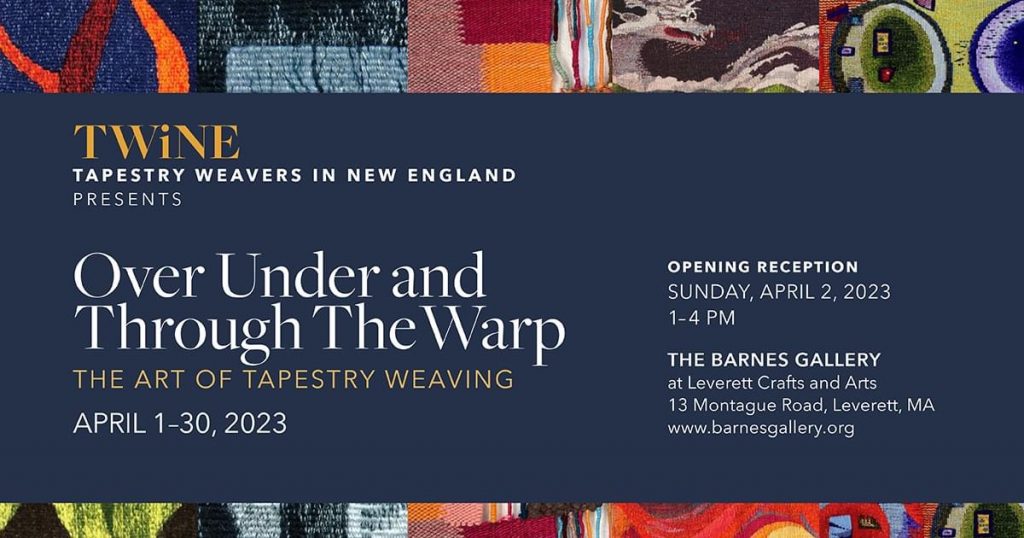Does that sound like a bureaucratic department in a communist state? Bingo. I am sorry to report that my visit to the Women’s Federation was a bit different than I expected. Yes, it was exciting…but it was also heavily overshadowed by some restraint on the part of the women I met. They had a reserve that was a bit unnerving to me, and none of them showed the enthusiasm for the handwork we had in common that I expected.
I met Noelis at the shop where the traditional clothing is for sale. Maria Estar was again on ‘display’ in a window making a small crocheted embellishment that would be attached to some item of clothing when finished. Noelis was happy to see me and led Bob and me on a walk for several blocks to the building of the Women’s Federation.
The building was a lovely old thing—I’d guess it was once a 19th century residence, one storey with a lovely front porchl. From the street entrance we cold barely see into a large, dark front room with a hallway running back. Beyond this was a wonderful view of the inner courtyard that had a lathwork ceiling draped in a bounty of magenta bougainvillea blooms.
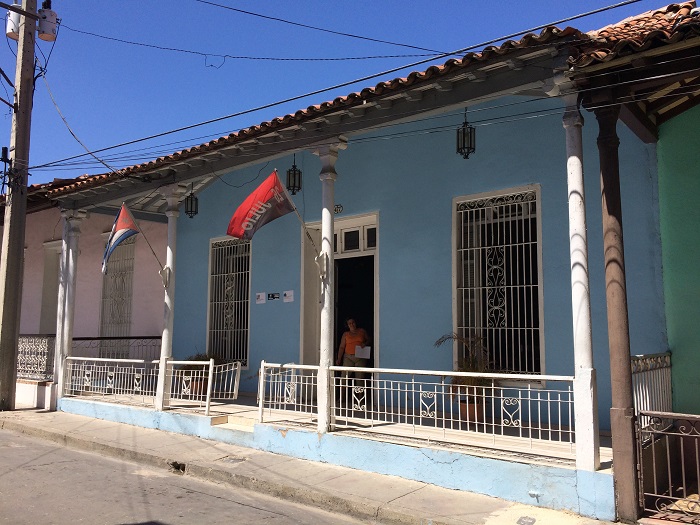 Noelis took us in to the first room where about a dozen women were sitting in a circle practicing their crochet. There was a man who was monitoring who came and went from a desk at the entrance. Noelis asked us to sit down near the desk while she got the ‘manager’ to come out to meet us.
Noelis took us in to the first room where about a dozen women were sitting in a circle practicing their crochet. There was a man who was monitoring who came and went from a desk at the entrance. Noelis asked us to sit down near the desk while she got the ‘manager’ to come out to meet us.
Some of the women looked up from their work and smiled at me. I was very excited at the prospect of getting to see what they were doing! I was right near them, but I already had the sense that I needed to stay in my seat as Noelis had instructed.
The manager was a woman about my age. She looked very approachable, and I think we could have had a great conversation if we had not needed a translator. Noelis was our translator, and I trusted her, but she had such a deference for the manager that I think she translated my words very formally. Certainly what she told me the manager was saying was also very formal. I was not speaking formally to these women, and I have a feeling from the friendliness in the manager’s eyes that she was not speaking formally to me either. I think a LOT was lost in translation.
They told me the purpose of the federation was to keep the techniques used in traditional textiles alive and make sure the traditional garments of Cuba continued to be valued and worn, if not for everyday use, at least for use in life’s traditional ceremonies, such as weddings and other religious events. The women pay to go to this school (60 pesos for 3 months of study and including a hot lunch), and then have the opportunity to make money with their handcrafts after reaching a certain level of proficiency.
There was a class going on in the lush courtyard and there was a large studio with sewing machines where women were sewing various items of clothing. The machines were all Jukis. The only clothing being made that I recognized with certainly was the men’s wedding shirt, called a guayabera. Noelis told me there are many traditional women’s costumes that have the same details as the guayabera.
The manager’s office was a cramped space with no window. The four of us—Noelis, the manager, Bob and I—were quite challenged in the space. At one point another woman came in and joined us. I know that Bob and I created some curiosity, but it seemed that most of the women did not feel comfortable showing it.
While I could see that all the sewing was being done with commercial white fabric (and I had felt the shirts in the shop, and they were not traditional 100% cotton, but some kind of cotton/polyester blend), I still felt compelled to ask if anyone in Cuba was weaving traditional fabric. Noelis did not recognize words ‘weaving’ and ‘loom’ so while we chatted Bob searched the photos on my phone for images of my looms and some of my handwoven fabrics. Once he found these both the manager and Noelis confirmed that no one is weaving in Cuba. They do not have the equipment, but they said some women ‘do this with a needle.’ Hmmm…. I wonder if they meant some kind of needle lace. They saw some photos of my tapestries (tapisaria) and said that is not done in Cuba either.
We talked for a while about bobbin lace, tatting, knitting and crochet. Bob asked if we could take some pictures, and this is when things got noticeably awkward for the women. The manager said (through Noelis) that we would have to go to the Federation headquarters in Havana to ask for permission to photograph. Hmmm… They seemed a bit leery of us from that point on. I tried to explain that women in the US who do handcrafts are very interested in knowing what women in other parts of the world do. That did not go well either. The manager gave me a brochure about the Federation and told me to visit Havana for permission. Bob attempted to tell them that we are living on a boat ….that this method of travel means we will not get to Havana until mid April and we will not get back to Santiago de Cuba, but they said they could not do anything without permission from their headquarters. So, very sadly, that photo at the beginning of this post is all I have to show.
Noelis took me on the rest of the short tour. It was afternoon at this point and almost all the women were sitting together in the courtyard, all eating the exact same lunch on plastic trays with molded dividers to separate the food items—very 1950s. Lunch was white rice, some kind of meat, and some vegetables. As I looked to the side of the courtyard, along the hallway we were walking down, I saw there was a large kitchen where lunches were prepared. So some women work at the Federation as kitchen staff.
Noelis took me to a group of women at a small table just at the back of the large front room we had entered first from the street. Behind a room divider separating them from the space where the crocheters had sat in a circle for their class was a large Spanish carved colonial dining table (and large, ornately carved Spanish china cabinets along that back wall) where women were sitting practicing their tatting…or frivolite. Noelis introduced me to the teacher and then asked me to show her my tatting. I was a bit horrified because of all the textile techniques I do this is the one I am most UNproficient at doing! I did not want the teacher to think that my work represented the quality of work done by women in the US! I asked Noelis to explain to her that I am very much a beginner, that I only started doing this when we left on our trip a couple of months ago, and that this was my second attempt at a trim of rings and chains for the neckline of a blouse.
Naturally, the teacher found all my mistakes in a moment! She had Noelis tell me that I didn’t always have the same number of stitches between my picots, and I must strive to always have the same number. Well, yeah… I do know that even though I haven’t managed it yet. Wish I could have explained that I did this work while bouncing about on a sailboat, usually sailing in gale force and near gale force winds…but I realize that would have been just looking for reasons to explain my faults! Then she said my picots were rather good but there were still tiny differences in sizes, and I needed to get more consistent with that as well. At the end she said that if I was a beginner I was doing very well. Still, I left feeling pretty mortified that of all the things I could have shown a teacher in this school, wouldn’t you know it would be the one thing I barely know!
Noelis escorted us out of the building, and as she left us to return to the shop where we met her (in the historic district) once again she said that she hoped we’d come back with permission from Havana, and that she ‘would be waiting for me.’
This incident put a quite a damper on my enjoyment of the rest of the day, I must say. I always get so excited to meet other textile makers, and I usually feel that it is a language we all share and a place where we can all have the same enthusiasm and ability to teach and to learn from each other. The whole proletariat attitude really took the wind out of my sails–sorry for the dumb pun–but I really felt deflated. Here were a group of women I would love to communicate with about subjects near and dear to all of us, and there was this terrible pall over the whole thing. There was a definite sense of propriety that these women exuded, and they seemed to be weighing their interest in talking to me against the rules of what was expected of them in representing this federation.
After a short walk back to the historic district, we were standing in the main parque when we were approached by someone who said he knew we were staying at the marina… I did not recognize him, although he said he works for the customs department at the marina. He remembered us from when we checked in, but I knew I had not seen him. He offered to show us some sights and find a place for us for lunch. In my newly deflated state I wondered if there was some agenda to his offer….
Well, there was, of course, but also he was generous with his knowledge. He took us to a local restaurant that I’m sure was owned by his family or friends. That was okay because it was a great place, and we would have no idea of how to find such a good local place on our own. ‘Paladares’ are family owned restaurants that the Cuban government has now sanctioned. There are many rules for running one of these: a limited number of customers may be served (I think it is 12), and they cannot serve foods that are reserved for gov’t run hotels and restaurants which includes lobster and the better cuts of chicken. Paladares may serve pork, some chicken, and local fish. We let the waiter choose our meal for us, and it was excellent! This particular place was on the 3rd floor balcony of a small residential building (typical Soviet block cement structure), and up on the balcony was an amazing view of the decayed apartment buildings all around that could have been anywhere from Kabul to Cairo with a backdrop of the stunning harbor.
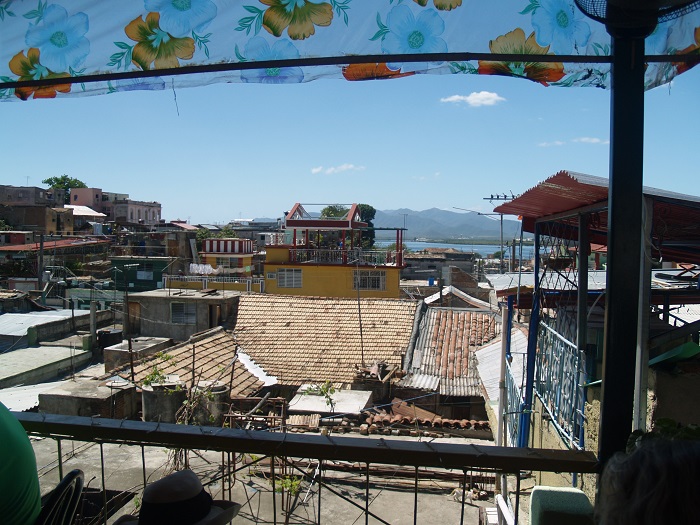
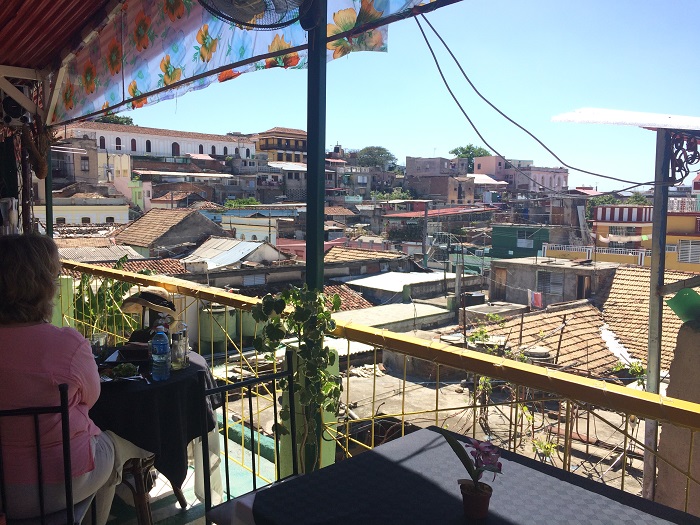 Some of the surrounding buildings had no roofs, or had makeshift roofs of corrugated tin with many holes and many repairs. All the buildings had windows with no glazing. On one rooftop balcony near us there was a dog that looked very much like our son’s dog Bobi. This gave me a little tinge of homesickness on the very day I was missing my son’s birthday. Well, I was certainly thinking of him.
Some of the surrounding buildings had no roofs, or had makeshift roofs of corrugated tin with many holes and many repairs. All the buildings had windows with no glazing. On one rooftop balcony near us there was a dog that looked very much like our son’s dog Bobi. This gave me a little tinge of homesickness on the very day I was missing my son’s birthday. Well, I was certainly thinking of him.
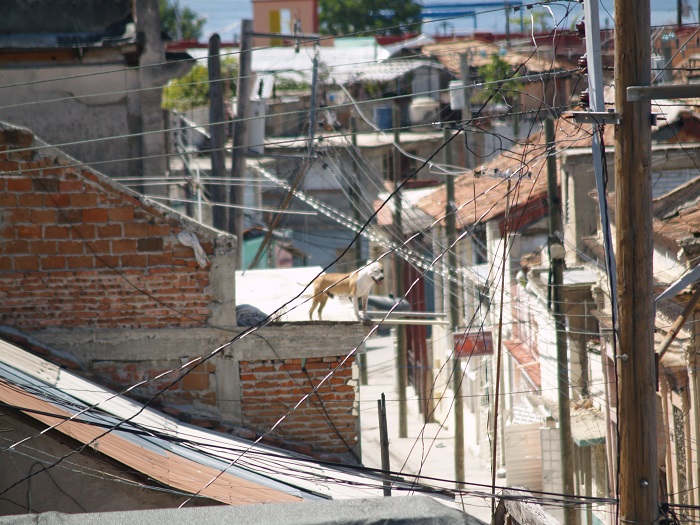 Our customs official cum tour guide offered to get us things—cigars, rum…from places that tourists cannot visit and therefore much less expensive. He admitted that he had some ‘relationships’ with these places that would give him a commission for what he sold. It was all a bit overwhelming for me. He said he got his very good job working for the state because of who he knew. He used the phrase “Who you do, who you know,” which sounded like everything was based on what you do for someone and who you know that can improve your own situation. I got that, but he must have wanted to make certain I understood because he added, “one hand washes the other.” –he could not possibly know that I learned this phrase in Latin in high school, about a million years ago! I guess I was too hot and too disappointed in my visit to the handcraft school to enjoy this information. Now, a day later Bob and I have discovered that he does not work for customs at the marina. He’s not the first person to recognize downtown in Santiago de Cuba—every seems to know who we are. I think we were had, but it was kind of fun anyway. Boy, these people know how to turn a trick.
Our customs official cum tour guide offered to get us things—cigars, rum…from places that tourists cannot visit and therefore much less expensive. He admitted that he had some ‘relationships’ with these places that would give him a commission for what he sold. It was all a bit overwhelming for me. He said he got his very good job working for the state because of who he knew. He used the phrase “Who you do, who you know,” which sounded like everything was based on what you do for someone and who you know that can improve your own situation. I got that, but he must have wanted to make certain I understood because he added, “one hand washes the other.” –he could not possibly know that I learned this phrase in Latin in high school, about a million years ago! I guess I was too hot and too disappointed in my visit to the handcraft school to enjoy this information. Now, a day later Bob and I have discovered that he does not work for customs at the marina. He’s not the first person to recognize downtown in Santiago de Cuba—every seems to know who we are. I think we were had, but it was kind of fun anyway. Boy, these people know how to turn a trick.
The day was hotter than the previous day, and when we returned to Pandora we had a very cold gin and tonic and a simple dinner of cheeses from France and Italy, and crackers from the UK , that we bought in Nassau. After washing a local mango in a basin full of water mixed with hydrogren peroxide, we ate it. No ill effects today. I might also add that I had a mojito at the paladar and a lemonade at the Casa Granda Hotel, both with ice cubes, and I am still alive. Whew!

